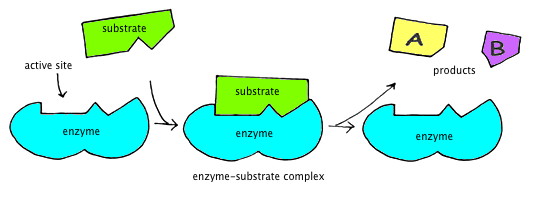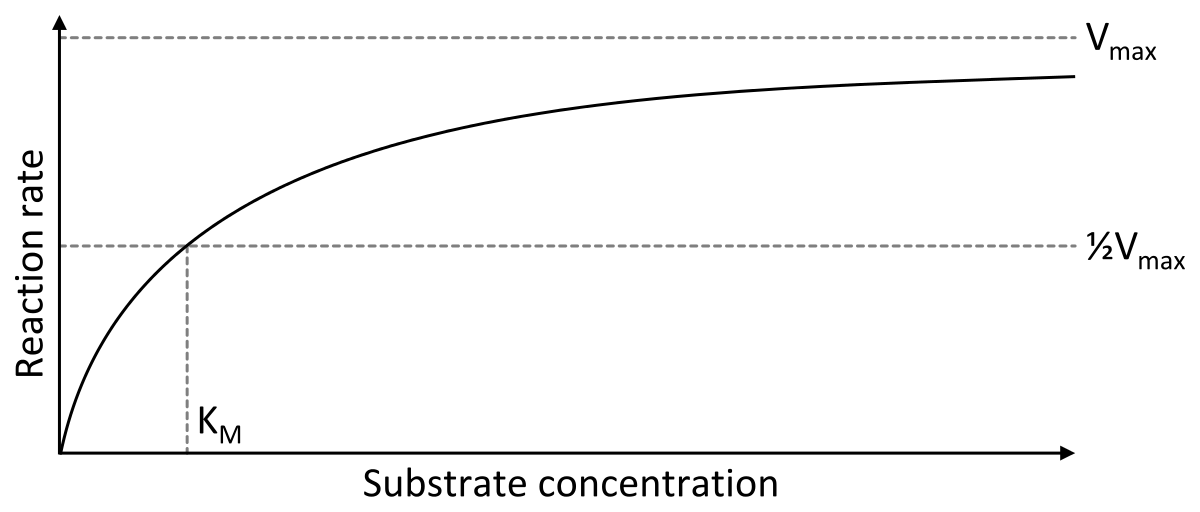Enzymes and Reaction Rates
Chemical reactions occur when molecules interact and chemical bonds between them are formed or broken. Some reactions will occur just by putting two substances in close proximity. For example, iron in the presence of oxygen will form iron oxide, or rust. Other reactions require energy to get the reaction started. Once the activation energy is added, the reaction will continue if the final energy state is lower than the initial energy state. A good example is a lightning strike that starts a forest fire which, once started, will continue to burn until the fuel is used up.
In biology, chemical reactions are often aided by enzymes, biological molecules made of proteins which can be thought of as facilitators or catalysts. Enzymes speed the reaction, or allow it to occur at lower energy levels and, once the reaction is complete, they are again available. In other words, they are not used up by the reaction and can be re-used. Enzymes are designed to work most effectively at a specific temperature and pH. Outside of this zone, they are less effective. At very high temperatures, enzymes, because they are made of protein, can be denatured or destroyed.
The material on which the enzyme will act is called the substrate. The enzyme attaches to the substrate molecule at a specific location called the active site. When the enzyme has attached to the substrate, the molecule is called the enzyme-substrate complex. For example, the sugar found in milk is called lactose. With the aid of the enzyme, lactase, the substrate, lactose, is broken down into two products, glucose and galactose.
People who don't make enough lactase have trouble digesting milk products and are
lactose intolerant. Children are usually lactose tolerant, but many people lose the ability to digest milk sugars as they grow older. Your probability of being lactose intolerant is correlated with whether your ancestors raised milk cows. The commercial product, Lactaid, contains lactase.
Enzyme action can be blocked by molecules that obstruct the enzyme's active site. Herbicides and pesticides often work in this way. The active site of an enzyme has a very specific 3-dimensional shape. Therefore, enzymes are specific to particular substrates, and will not work on others with different configurations.
| Enzyme |
Substrate |
Products |
| Amylase |
Starch |
Simpler sugars |
| Lactase |
Lactose |
Glucose and galactose |
| Catalase |
Hydrogen peroxide (H2O2) |
Water (H2O) and oxygen (O2) |
| Carbonic Anhydrase |
Bicarbonate (H2CO3) |
Water (H2O) and carbon dioxide (CO2) |
Some examples of enzymes and their specific substrates.
There are several factors that can increase the rate of a reaction. Raising the temperature can speed a reaction because the molecules have more energy and therefore bump into each other more frequently. The same effect can be obtained by physically stirring the ingredients. A reaction can also be speeded by increasing the concentration of reactants, the chemicals that are necessary for the reaction to proceed; this is called the Law of Mass Action, or by decreasing the concentration of products, the chemicals that result from the reaction. Some reactions can even run in both directions depending on the concentration of molecules. For example, carbonic anhydrase can catalyse the conversion of bicarbonate, a blood pH buffer, into water and carbon dioxide, or can catalyse the reaction in the opposite direction when water and carbon dioxide are more abundant.
The graph below shows that the rate or velocity (V) of a reaction depends on substrate (K) concentration up to a limit. KM is the substrate concentration midway to the maximum rate, and is a useful value to note since the reaction is non-linear, and return on substrate investment diminishes as we approach the maximum rate (Vmax). If the substrate is valuable, we can think of KM as the optimal amount of substrate to invest. If the substrate is inexpensive, then saturating the reaction with substrate ensures the most product in the shortest period of time. As we approach Vmax, more and more of the enzyme is involved with substrate, so no further increase in substrate concentration can speed the reaction further.
Lab Source: http://www.learnnc.org/lp/pages/3398
Lab Activity: Testing the action of the enzyme, lactase, on lactose and sucrose, two disaccharide sugars.
Introduction: Lactose is a disaccharide sugar found in milk, and is composed of two simpler sugars, glucose, a six-sided molecule, and galactose, another six-sided molecule. The enzyme, lactase (enzyme names often end in -ase) breaks lactose into its two monosaccharide components. Sucrose, or table sugar, is another common sugar composed of glucose and fructose, a five-sided molecule. In this lab, we will use the enzyme lactase to attempt to break down both of these disaccharides.
Materials:
- Water
- Milk
- Lactaid tablets (available from grocery or drug store)
- Glucose test strips (available from drug store)
- Table Sugar
Solution Preparation:
- Lactose solution: Milk, about 100 ml.
- Sucrose Solution: Add 5 grams of sugar to 100 ml of water. Stir until the sugar has dissolved.
- Enzyme Solution: Add 1 lactase tablet to 200 ml of water. Stir until the tablet has dissolved.
- Denatured Enzyme Solution:
- Place 20 ml of Enzyme Solution into a glass container such as a canning jar.
- Add 200 ml of water, and then seal the lid.
- Add the canning jar to a pot of water, and bring the pot of water to a boil.
- Boil for ~30 minutes.
- Let the solution cool to room temperature.
Procedures:
- Divide the lactose solution and sucrose solution into two containers each. Be sure to label the containers.
- Add the enzyme solution to one, and the denatured enzyme solution to the other.
- Dip an unused glucose test strip into each container and record whether glucose is detected in the table below.
| |
Glucose Detected? |
| |
Enzyme Solution |
Denatured Enzyme Solution |
| Lactose solution |
+ / - |
+ / - |
| Sucrose solution |
+ / - |
+ / - |
Circle the + if glucose was detected, or the - if glucose is not detected.
Questions:
- Why did lactose + enzyme test positive for glucose? What must have happened?
- Why did the sucrose solution test negative for glucose, since we know that glucose + fructose = sucrose?
- What must have happened to the enzyme solution when boiled?
- Why did the lactose solution test negative for glucose with the denatured enzyme solution?
- If heating speeds a reaction, why does boiling not speed it up even more?
- Explain, with reference to substrate concentration, the difference between the optimal and maximum rate of a reaction.
- What is the Law of Mass Action?
- What happens if the active site of an enzyme can be blocked?
- What happens when an enzyme is denatured?
- What is a catalyst?



